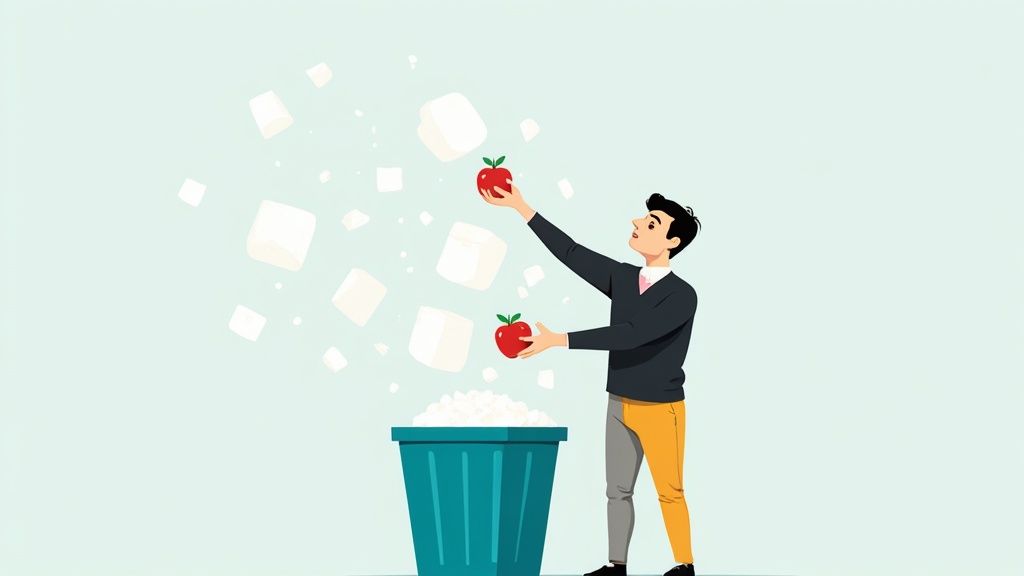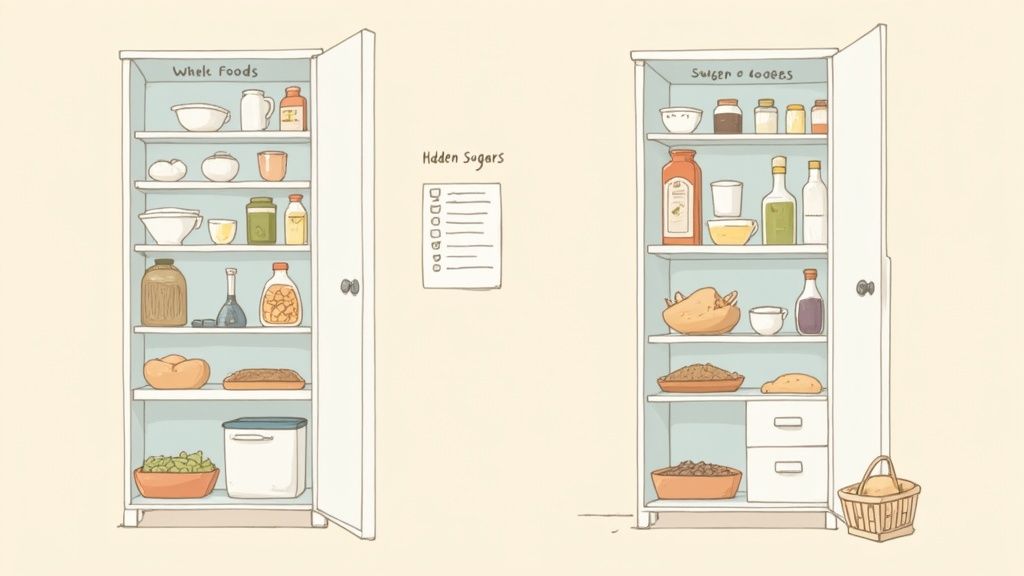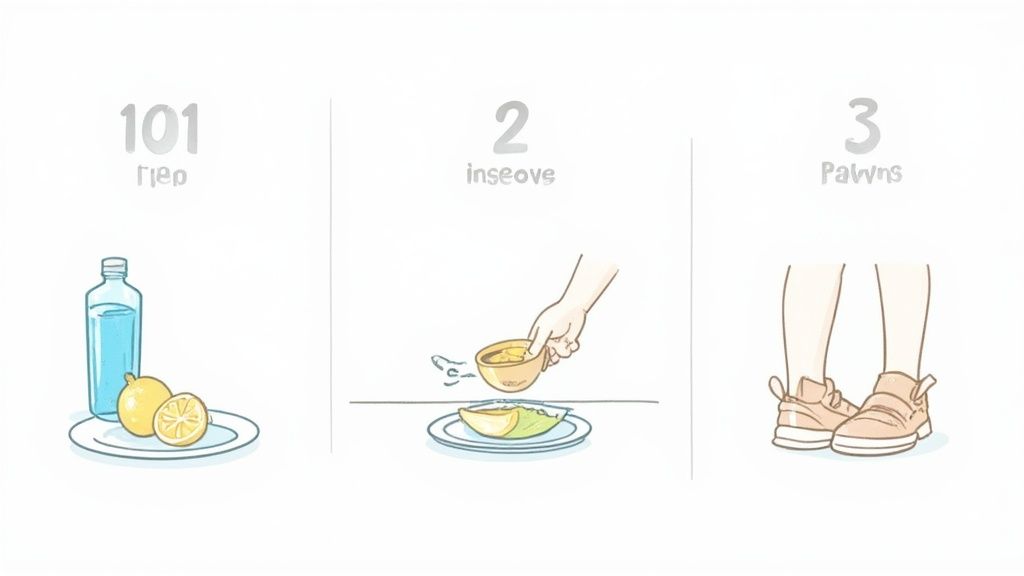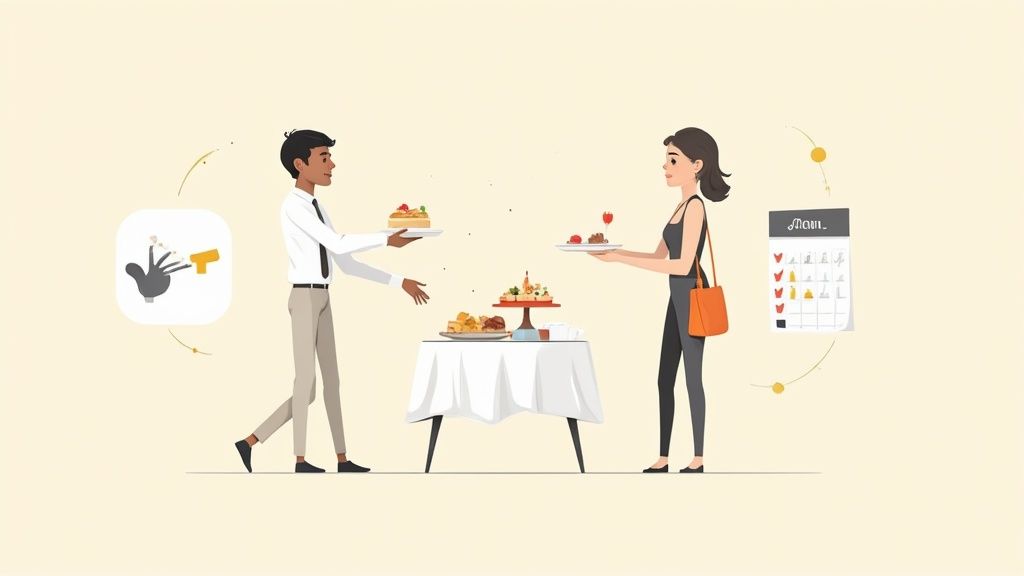quit sugar cold turkey: practical steps to break free

If you've ever tried to quit sugar cold turkey and felt like you failed, let me tell you something: it wasn't a lack of willpower. It was a biological battle, plain and simple.
The whole process can feel impossible because sugar literally hijacks your brain's reward system, kicking off withdrawal symptoms that feel a lot like what you'd expect from an addictive substance. Getting your head around this fact is the first, most important step toward actually succeeding this time.
Why Your Brain Fights Back
Ever sworn off sugar in the morning, only to find yourself irritable, exhausted, and fighting a splitting headache by the afternoon? You're not alone, and there’s a very real scientific reason for that struggle. Your body isn't just missing a treat; it's physically reacting to the absence of a powerful chemical it has come to depend on.
This intense reaction all comes down to how sugar messes with your brain. Eating sugar triggers a flood of dopamine—the "feel-good" chemical—in the same reward centers of the brain that light up with addictive drugs. Over time, your brain gets used to this and starts needing more and more sugar to get that same happy buzz. And just like that, a dependency cycle is born.
The Science of Sugar Withdrawal
When you suddenly cut off the supply, your brain chemistry gets thrown for a loop. This is where the really tough withdrawal symptoms kick in. Since your brain's reward system has been getting a steady "hit" from sugar, taking it away causes a series of neurochemical and behavioral changes that mirror classic withdrawal.
This timeline gives you a good idea of what to expect, from the initial headaches to that eventual feeling of renewed energy.

As you can see, the toughest physical symptoms usually hit their peak within that first week. Stick it out, and you’ll start to feel your energy levels bounce back as your body adjusts.
A Realistic Timeline for Sugar Withdrawal
Here’s a look at the common withdrawal symptoms you might face and when they typically appear.
| Symptom | Typical Onset | Why It Happens |
|---|---|---|
| Intense Headaches | Days 1-3 | Your body is reacting to the sudden drop in sugar and dopamine levels. |
| Overwhelming Fatigue | Days 2-5 | Your system is learning to use fat for fuel instead of readily available sugar. |
| Irritability/Mood Swings | Days 2-7 | Fluctuating dopamine levels can make you feel snappy and emotionally unstable. |
| Brain Fog | Days 3-7 | Your brain is recalibrating and getting used to a new, cleaner energy source. |
Remember, this is a temporary phase. Your body is incredibly resilient and is working hard to find its new normal.
It's a Physical and Mental Challenge
This is so much more than just a craving; it's a full-body experience. You might feel a nasty combination of symptoms that make it hard to just get through the day:
- Intense Headaches: Often one of the first and most common signs.
- Overwhelming Fatigue: Your body is adjusting to a new primary energy source.
- Irritability and Mood Swings: Caused by those fluctuating dopamine levels.
- Brain Fog: Difficulty concentrating is common as your brain recalibrates.
The key takeaway is that these symptoms are real, physiological responses. They are not a sign of personal failure but rather evidence that your body is healing and resetting itself.
Before you jump in, it’s a good idea to spend a little time exploring different 'cold turkey' approaches and alternatives to find what might work best for you. When you accept the biological reality of what you're up against, you can go into it with a much smarter strategy—and a lot more compassion for yourself as you navigate those first few hurdles.
Setting the Stage: Prepping Your Kitchen and Your Mind

Let's be honest: your success with quitting sugar cold turkey is pretty much decided before you even eat your last cookie. How you prepare your environment and your mindset for the challenge ahead isn't just a nice-to-do; it's the bedrock of your entire effort.
Think of it as setting the rules of the game so you can actually win.
The Great Pantry Purge
First things first: your kitchen. This is where the battle is won or lost, and a ruthless pantry purge is your first move. This goes way beyond just tossing the obvious culprits like candy and ice cream. The real enemy is the hidden sugar, the stuff lurking in foods you'd never suspect.
It's time to become a label detective. Sugar has a ton of aliases—high-fructose corn syrup, dextrose, sucrose, barley malt, and dozens more. It’s hiding in plain sight, often in foods marketed as “healthy.”
Your mission is to find and eliminate these saboteurs. Check everything:
- Condiments & Sauces: Ketchup, BBQ sauce, Sriracha, and most salad dressings are loaded with sugar.
- "Healthy" Snacks: Look at those granola bars, flavored yogurts, and even dried fruit. The sugar content can be staggering.
- Savory Foods: Yep, check your bread, crackers, and pasta sauces. You'll be shocked at where manufacturers sneak it in.
When you clear your kitchen of these temptations, you’re making a pact with your future self. When a craving strikes at 9 p.m., the only options available will be ones that help you, not hurt you.
Restocking for the Win
Once the coast is clear, you need to bring in the good stuff. Your new grocery list should be all about whole, unprocessed foods that will keep you full and fight off cravings.
Build your meals around these power players:
- Lean Proteins: Chicken, fish, eggs, tofu, and legumes are your best friends. They keep your blood sugar stable and help you feel satisfied.
- Healthy Fats: Don't fear fat! Avocado, nuts, seeds, and good-quality olive oil are crucial for feeling full and shutting down cravings.
- Fiber-Rich Veggies: Load up your cart with leafy greens, broccoli, bell peppers, and cauliflower. Fiber is key for digestion and that "I'm full" feeling.
If you want a more structured game plan, we have detailed meal ideas in our complete guide to starting a sugar detox for beginners. A little prep makes it so much easier to grab a healthy meal instead of caving and ordering takeout.
Getting Your Head in the Game
Your mental prep is just as important as cleaning out the pantry. You need to know why you're doing this. Is it for more energy? Clearer skin? To finally get control over your health?
Whatever it is, write it down. Stick it on your fridge. Make it your phone's wallpaper. This "why" is what you'll hang onto when things get tough.
Next, talk to your people. Let your family and close friends know what you're doing and how they can support you. A simple, "Hey, I'm quitting sugar for a while, and I'd really appreciate it if you didn't offer me any sweets," can make a massive difference.
Finally, plan how you'll celebrate your wins. Kicking a sugar habit is a huge deal! But the rewards can't be food. Think about things that will actually make you feel good long-term:
- A massage after a tough first week.
- That new book you've been wanting to read.
- A weekend hike to celebrate one month sugar-free.
This isn't just about treats; it's about actively rewiring your brain's reward system away from sugar and toward experiences that genuinely nourish you.
Surviving the First 72 Hours of Sugar Withdrawal

Let's be honest: the first three days of quitting sugar cold turkey are the hardest. There's no sugarcoating it. This isn't just in your head; your body is physically adjusting, and it’s going to protest. But if you have the right game plan, you can get through this critical window and emerge stronger on the other side.
Think of these first 72 hours as a short but intense storm. Your only job is to hunker down and ride it out. The goal isn't to feel fantastic—it's just to survive.
Moment-by-Moment Survival Tactics
When that first withdrawal headache hits, don't just reach for a painkiller. You can get ahead of it. Instead of plain water, try adding a pinch of good sea salt and a squeeze of fresh lemon. This simple trick helps restore your electrolytes, which often get thrown out of whack during detox and can make those headaches so much worse.
Then there's the infamous 3 p.m. energy crash. This is when a sugar craving loves to show up, and it hits like a ton of bricks. You need a plan ready to go before the slump even begins.
Here’s a simple, actionable strategy for that afternoon crash:
- Protein First: Around 2 p.m., have a protein-heavy snack like a hard-boiled egg or a small handful of almonds. This will help stabilize your blood sugar before it has a chance to nosedive.
- Cold Shock: Grab an ice-cold, unsweetened drink. I've found that a frosty glass of herbal tea or sparkling water can provide just enough of a jolt to interrupt a craving's momentum.
- Change Your Scenery: Don't just sit there and wrestle with the urge. Get up. Walk around the block, or just step outside for five minutes of fresh air. That small physical and mental shift can be enough to derail the craving completely.
If you're wondering just how intense these reactions can be, we've broken it all down in our detailed guide on the most common sugar withdrawal symptoms.
Proactive Measures to Stay Ahead
Instead of just playing defense, you can take steps to keep the worst of the symptoms at bay. Your best weapon is stable blood sugar. Kick off your day with a breakfast loaded with protein and healthy fats—think scrambled eggs with avocado, not a sugary bowl of cereal. This sets a solid, steady energy baseline for the whole day.
Distraction is another powerful ally. When you feel a craving creeping in, don't try to stare it down with willpower alone.
Willpower is a muscle, and during withdrawal, it's already exhausted. Don't fight the craving head-on; redirect your brain's attention instead.
Try this simple five-minute distraction drill:
- Acknowledge it: Just say to yourself, "Okay, a craving is here." Don't fight it, just name it.
- Use your hands: Immediately do something physical. Wash a few dishes, tidy a messy drawer, or do a couple of quick stretches.
- Engage your mind: Pop on a podcast, blast an upbeat song, or call a friend to talk about anything other than food.
It’s worth remembering that the challenge is bigger than just us. Global sugar consumption is skyrocketing and projected to hit 202 million metric tons by 2034. That means sugary foods are everywhere, making our personal efforts that much more important. This trend highlights why having a personal strategy is non-negotiable when society's habits are often working against you.
Building Habits for Long-Term Sugar Freedom

Getting through that first week is a huge win, but the real victory comes from making this a permanent change. This is the part where you shift from just surviving the initial detox to building new, healthy habits that actually stick around.
The end game isn't just about quitting sugar; it's about creating a life where you don't feel like you're missing out or constantly fighting temptation. And that means having a game plan for the real world—a world full of office birthday cakes, holiday parties, and friends who just want you to have a slice of pie.
Navigating Tricky Social Situations
Let's be honest, social pressure is one of the biggest hurdles. Most of the time, when someone offers you a treat, they’re just being kind. Having a few go-to responses in your back pocket can make these moments way less awkward.
Instead of a flat "I don't eat sugar," which can come off a bit harsh, try something softer. A simple, "No thanks, I'm cutting back on sugar and I feel so much better for it," is positive and all about you, not them.
Another great move? Bring your own amazing, sugar-free alternative to parties. Show up with a gorgeous fruit platter, a bowl of spiced nuts, or a veggie tray with a killer dip. Not only do you have something safe to snack on, but you’re also contributing to the fun. It’s a total power move.
The secret is to reframe how you think about it. You aren't depriving yourself; you are choosing to have more energy and feel better. That small mental shift is everything.
Taming Emotional Eating Triggers
For so many of us, sugar is more than just food—it’s a crutch. We grab it when we're stressed, bored, sad, or even when we're celebrating a win. Breaking that emotional link means figuring out your triggers and finding new ways to deal with those feelings that don't involve a candy bar.
Start by paying attention. The next time a massive craving hits, just pause for a second and ask yourself, "What am I really feeling right now?"
- Stressed? Instead of a cookie, try a five-minute walk, a few deep breaths, or putting on a song that chills you out.
- Bored? A sugary snack gives you a quick hit, but it doesn't solve the problem. Try tackling a small five-minute project, calling a friend, or picking up that book you’ve been meaning to read.
- Sad or lonely? Sugar might feel like a hug, but it’s a temporary one that usually ends in a crash. It’s far better to call someone you trust, write down what you’re feeling, or cuddle with your pet.
You're essentially building a new toolkit for handling life. At first, you'll have to consciously choose these new reactions. But with a little practice, they'll become second nature, replacing that old urge to reach for sugar. This is how you build real, lasting freedom from cravings.
Using Technology to Reinforce Your New Habits
https://www.youtube.com/embed/HHI-7I9kD5k
When you decide to go cold turkey on sugar, you don't have to white-knuckle it alone. The right tools can give you real-time feedback and a gentle nudge just when you need it most.
Think of an app like StopSugar as an accountability partner in your pocket. It combines a daily sugar-free check-in with a mood tracker, which is brilliant for spotting the patterns between how you feel and when a craving hits. The best part? Logging only takes a few seconds.
This isn't just about tracking data; it's about turning that data into clear, actionable insights that help you stay on track.
- Daily Tracker: This is where you'll log your sugar intake and mood. It quickly creates a map of your personal highs and lows.
- Panic Button: At the first hint of a craving, this feature connects you with tips and quick exercises to get you through the moment.
- Recipe Database: It completely solves the "what on earth can I eat now?" problem with hundreds of genuinely tasty sugar-free meal ideas.
If you're exploring other options, we've also put together a guide to the best habit tracking apps that can help build and reinforce your new routine.
Tracking Your Mood and Cravings
Imagine this: every evening, you take a minute to review your check-ins and start noticing that your toughest cravings always pop up after a stressful meeting or a difficult conversation. This simple routine is how you build powerful self-awareness.
Logging those energy slumps right alongside the tough moments helps you pinpoint your specific emotional triggers. Once you know what they are, you can prepare for them ahead of time.
Catching stress-related cravings early cuts them off at the pass, long before they have a chance to take hold.
It's also encouraging to know that bigger forces are moving in the right direction. For instance, in 2024/25, the United States saw a 2.4% drop in sugar deliveries for food and beverages, partly thanks to new taxes and policy shifts. Read the full research about sugar policy impacts
Tapping Into Community Support
That late-night craving just hit, and you feel like you're about to give in. You don't have to fight it alone. This is where something like an in-app community chat becomes a lifesaver.
Instead of pacing around your kitchen, you can:
- Jump into the chat and share what's happening.
- Ask for quick distraction ideas or stories from people who've been there.
- Pay it forward by offering your own advice when you're feeling strong.
Sharing your struggles and successes with people on the exact same journey is a massive motivator. I've seen countless people say that a quick five-minute pep talk from a stranger was all it took to stop an urge in its tracks.
And when you're staring into the fridge, completely uninspired, lean on the recipe database. It’s packed with breakfast, lunch, and dinner ideas designed specifically for this journey. Just scrolling through the options can spark some excitement and save you from decision fatigue.
Using technology smartly means you’re not just relying on willpower. You're stepping into a support system that learns and grows with you, turning a daunting challenge into a manageable, one-day-at-a-time journey.
Got Questions About Quitting Sugar? Let's Clear Things Up.
Deciding to go cold turkey on sugar is a big step, and it's totally normal for a bunch of questions to start swirling around. Getting straight answers can be the difference between powering through and throwing in the towel. Let's tackle some of the most common things people wonder about when they start this journey.
How Long Does Sugar Withdrawal Really Last?
Let's be real: the first few days can be rough. For most folks, the worst of the physical stuff—think pounding headaches, brain fog, and serious fatigue—really hits its peak in the first 2 to 3 days.
After you get over that initial hump, the physical symptoms start to fade pretty quickly, usually within a week or two as your body adjusts. It's the mental cravings that can linger a bit longer, but that's a different battle.
Your main mission is to conquer those first 72 hours. Once you're past that, you've broken the back of the worst physical withdrawal, and every single day gets easier.
Your own timeline will depend on how much sugar you were eating before and your unique metabolism, but that first week is the major hurdle.
So, Is Fruit Off the Table?
Great question. The answer really depends on how strict you want to be.
If you're going for a true "cold turkey" reset, I've seen many people have the most success by cutting out all sources of sweetness, including fruit, for the first 1-2 weeks. This gives your taste buds a complete overhaul and helps kill the intense psychological need for a sweet taste.
After that initial detox phase, bringing whole fruits back into your diet is a fantastic idea. The fiber in a whole apple, for instance, is a total game-changer. It slows down how your body absorbs the fruit's natural sugar (fructose), which helps you avoid the crazy blood sugar roller coaster you get from candy or soda.
When you're ready to add fruit back in, start with lower-sugar options.
- Berries: Think raspberries, blackberries, and strawberries. They’re loaded with fiber.
- Green Apples: A tart Granny Smith has less sugar than a sweeter Red Delicious.
- Citrus Fruits: Oranges and grapefruits are great for a sweet fix that also delivers a dose of vitamin C.
What Are the Best Snacks to Crush a Craving?
When a craving strikes, you need a go-to snack that will actually help, not make things worse. The magic formula is a combination of protein, healthy fats, and fiber. This trio works together to keep your blood sugar stable and make you feel genuinely full and satisfied.
Having these ready to go is your secret weapon. It stops you from making a desperate, impulsive grab for the first sugary thing you see when your energy dips.
Try stocking your kitchen with some of these easy options:
- A handful of almonds or walnuts
- Celery sticks with almond butter
- A hard-boiled egg
- Sliced avocado with a pinch of sea salt (sounds weird, but the creamy texture and healthy fats are amazing at shutting down cravings fast).